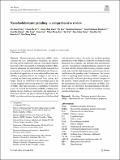| dc.contributor.author | Song, Yu-Xiang | |
| dc.contributor.author | Li, Chang-He | |
| dc.contributor.author | Zhou, Zong-Ming | |
| dc.contributor.author | Liu, Bo | |
| dc.contributor.author | Sharma, Shubham | |
| dc.contributor.author | Dambatta, Yusuf Suleiman | |
| dc.contributor.author | Zhang, Yan-Bin | |
| dc.contributor.author | Yang, Min | |
| dc.contributor.author | Gao, Teng | |
| dc.contributor.author | Liu, Ming-Zheng | |
| dc.contributor.author | Cui, Xin | |
| dc.contributor.author | Wang, Xiao-Ming | |
| dc.contributor.author | Xu, Wen-Hao | |
| dc.contributor.author | Li, Run-Ze | |
| dc.contributor.author | Wang, Da-Zhong | |
| dc.date.accessioned | 2024-03-11T16:44:26Z | |
| dc.date.available | 2024-03-11T16:44:26Z | |
| dc.date.issued | 2024-03-09 | |
| dc.identifier.issn | 2095-3127 | |
| dc.identifier.issn | 2195-3597 | |
| dc.identifier.uri | https://hdl.handle.net/1721.1/153653 | |
| dc.description.abstract | Minimum quantity lubrication (MQL), which considers the cost, sustainability, flexibility, and quality, has been actively explored by scholars. Nanoadditive phases have been widely investigated as atomizing media for MQL, aimed at enhancing the heat transfer and friction reduction performance of vegetable-oil-based biolubricants. However, the industrial application of nano-enhanced biolubricants (NEBL) in grinding wheels and workpiece interfaces as a cooling and lubricating medium still faces serious challenges, which are attributed to the knowledge gap in the current mapping between the properties and grindability of NEBL. This paper presents a comprehensive literature review of research developments in NEBL grinding, highlighting the key challenges, and clarifies the application of blind spots. Firstly, the physicochemical properties of the NEBL are elaborated from the perspective of the base fluid and nanoadditive phase. Secondly, the excellent grinding performance of the NEBL is clarified by its distinctive film formation, heat transfer, and multiple-field mobilization capacity. Nanoparticles with high thermal conductivity and excellent extreme-pressure film-forming properties significantly improved the high-temperature and extreme-friction conditions in the grinding zone. Furthermore, the sustainability of applying small amounts of NEBL to grinding is systematically evaluated, providing valuable insights for the industry. Finally, perspectives are proposed to address the engineering and scientific bottlenecks of NEBL. This review aims to contribute to the understanding of the effective mechanisms of NEBL and the development of green grinding technologies. | en_US |
| dc.publisher | Springer Science and Business Media LLC | en_US |
| dc.relation.isversionof | 10.1007/s40436-023-00477-7 | en_US |
| dc.rights | Creative Commons Attribution | en_US |
| dc.rights.uri | https://creativecommons.org/licenses/by/4.0/ | en_US |
| dc.source | Springer Nature | en_US |
| dc.subject | Industrial and Manufacturing Engineering | en_US |
| dc.subject | Polymers and Plastics | en_US |
| dc.subject | Mechanical Engineering | en_US |
| dc.subject | Mechanics of Materials | en_US |
| dc.title | Nanobiolubricant grinding: a comprehensive review | en_US |
| dc.type | Article | en_US |
| dc.identifier.citation | Song, YX., Li, CH., Zhou, ZM. et al. Nanobiolubricant grinding: a comprehensive review. Adv. Manuf. (2024). | en_US |
| dc.contributor.department | Massachusetts Institute of Technology. Department of Mechanical Engineering | |
| dc.relation.journal | Advances in Manufacturing | en_US |
| dc.eprint.version | Final published version | en_US |
| dc.type.uri | http://purl.org/eprint/type/JournalArticle | en_US |
| eprint.status | http://purl.org/eprint/status/PeerReviewed | en_US |
| dc.date.updated | 2024-03-10T04:09:10Z | |
| dc.language.rfc3066 | en | |
| dc.rights.holder | The Author(s) | |
| dspace.date.submission | 2024-03-10T04:09:10Z | |
| mit.license | PUBLISHER_CC | |
| mit.metadata.status | Authority Work and Publication Information Needed | en_US |
